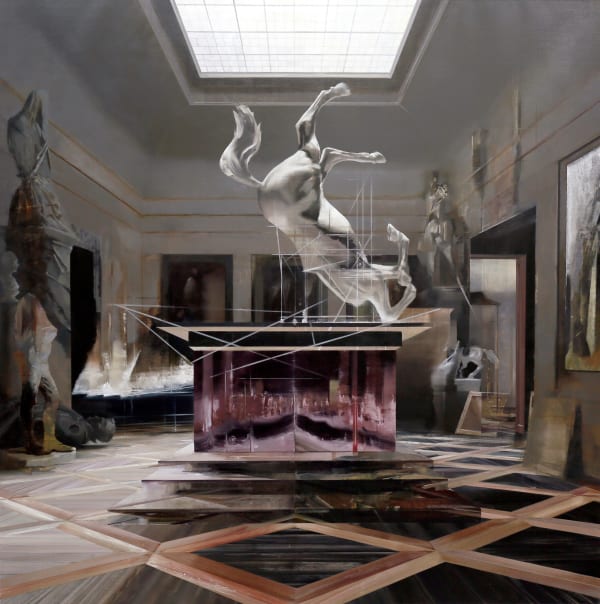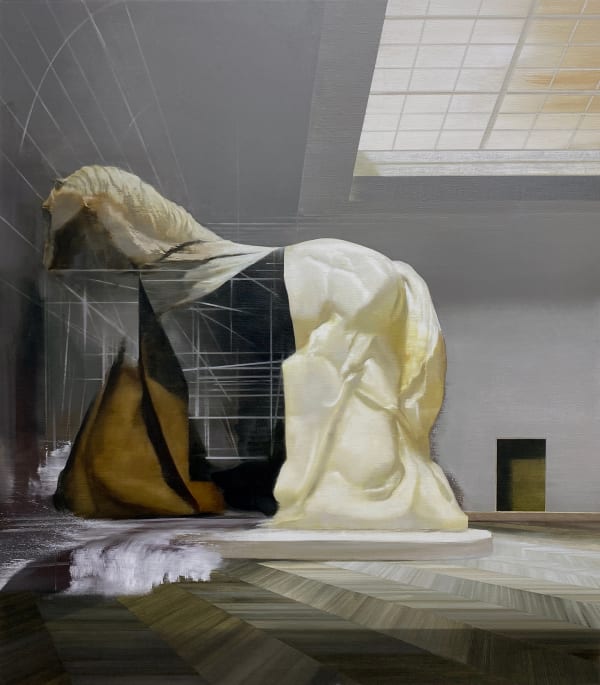-
 Tim Kent, The Lacquered Screen, 2024, Oil on linen, 50 x 49 5/8 in, 127 x 126 cm
Tim Kent, The Lacquered Screen, 2024, Oil on linen, 50 x 49 5/8 in, 127 x 126 cmTime and Memory
Histories in Flux presents twelve psychologically charged portraits, architectural depictions of estates, and cultural institutions that highlight key issues pertaining to class, access, privacy and consumption. Kent resists and highlights the conformity presumed in traditional painting genres, attuned to the issues of the contemporary. His work sees Baroque and Georgian interior spaces transformed and dissected, revealing an ominous past that contains its own dimensional terrain.
Kent's inspiration stems from his time studying at West Dean College where he was invited to engage the legacies of historic homes in contemporary renderings, igniting his fascination with architectural space. His childhood also influences his artistry, as a first-generation American with a single mother, the constant movement and subsequent lack of continuity allowed him to form places as memories to distinguish time, "My work attempts to express a narrative based around the mechanism of history and personal memory, which in turn are produced by the visual structures of power that inform our experience".
-

Tim Kent, Inclinations, 2024, Oil on linen, 64 3/4 x 78 in,164.5 x 198 cm -
 Tim Kent, Menagerie, 2024, Oil on canvas, 60 1/4 x 53 3/4 in, 153 x 136.5 cm
Tim Kent, Menagerie, 2024, Oil on canvas, 60 1/4 x 53 3/4 in, 153 x 136.5 cm -
Archive II
by William Corwin Tim Kent, Archive II, 2023, Oil and acrylic on linen, 76 x 76 in, 193 x 193 cmThe comedy of manners is a gentler setting for Kent's philosophical transgression, and his sweet spot actually manifests most presciently in terms of our notions of collecting, monumental sculpture, and what martial objects represent even in today's contemporary culture. In Archive II, a sculpture of an overturned horse rests atop a grandiose plinth in a gallery filled with other similarly epic sculptures and majestic paintings. We imagine that the sculpture is part of an equestrian typology, sans rider, but the horse also seems to be descending precipitously from a luminous skylight. The plinth itself is an altar rather than simply a support for a sculpture. While indistinct, it seems to have an image playing on the surface facing us. Screens and images seem to flicker in and out of our perception, a canvas lying against a wall in the background is only half there.
Tim Kent, Archive II, 2023, Oil and acrylic on linen, 76 x 76 in, 193 x 193 cmThe comedy of manners is a gentler setting for Kent's philosophical transgression, and his sweet spot actually manifests most presciently in terms of our notions of collecting, monumental sculpture, and what martial objects represent even in today's contemporary culture. In Archive II, a sculpture of an overturned horse rests atop a grandiose plinth in a gallery filled with other similarly epic sculptures and majestic paintings. We imagine that the sculpture is part of an equestrian typology, sans rider, but the horse also seems to be descending precipitously from a luminous skylight. The plinth itself is an altar rather than simply a support for a sculpture. While indistinct, it seems to have an image playing on the surface facing us. Screens and images seem to flicker in and out of our perception, a canvas lying against a wall in the background is only half there. -
Contested Histories
The construction of these obscured historic scenescapes alludes to questions concerning our understanding of history. Busts, portraits, monuments, museum spaces, and estates, all serve as vessels for thematic parallels deeply rooted in classism, elitism, and power dynamics. Through his portrayal of these traditional art historical archetypes, Kent exposes the controversial and often overlooked narratives woven into the fabric of art history's canon. Institutional spaces proudly showcase their collections as symbols of cultural education and progress, yet beneath this veneer lies a concealed tapestry of colonial dominance, imperial knowledge systems, class stratification and labour obfuscation. Kent's compositions unearth the underlying complex networks, dismantling and deconstructing these familiar symbols of tradition. Layering their veneer of opulence and allure with shadows and uncertainties, he makes these once-celebrated spaces stark objects that challenge viewers to confront the uncomfortable realities obscured by centuries of glorification.
-
Muniments II
by William Corwin Tim Kent, Muniments II, 2023, Oil on linen, 40 x 35 in, 101.6 x 88.9 cm
Tim Kent, Muniments II, 2023, Oil on linen, 40 x 35 in, 101.6 x 88.9 cmMuniments II is more staid in its energy, but the disintegration of our perception is more prominent than Archive II. Another rider-less but this time more docile equestrian statue dominates the picture plane; the muzzle and forehead of the horse pressed against the wall, as most of the head and forequarters have dissolved to expose a skeleton of perspectival lines and shadows. Kent highlights the unity of the statue and the space around it with these lines, again implying that the presence of objects is merely a serendipitous visual manifestation of hidden ever-present geometries. These regulating lines also appear in the marquetry of the wooden floor and the grid of the skylight.
Decidedly nihilistic in its politics, the missing rider, his horse, and even the museum itself are in the process of disappearing before our eyes. As an antidote to this entropy of human involvement, the state of nature seeps into the picture, as we saw in Kent's cycle of paintings exhibited in the show Dark Pools and Data Lakes (2018), and we see this happening in Histories in Flux in Muniments II at the base of the horse in the form of a cascade of flooding water emerging from the left. For Kent, at some point, the illusion stops, whether this is in the bleak landscape of a now devastated earth, or the equally grim back walls of an artist's studio. There is something underneath the illusions: regardless of how much devastation and slight-of-hand we inflict. Nature will persist, regardless if we package our own realities in portraits, landscapes, history paintings or nudes: it transcends genre.
-
-
 Tim Kent, Archive II, 2023 Sold
Tim Kent, Archive II, 2023 Sold -
 Tim Kent, Arts Work , 2024 Sold
Tim Kent, Arts Work , 2024 Sold -
 Tim Kent, By Careful Design, 2024
Tim Kent, By Careful Design, 2024 -
 Tim Kent, Inclinations, 2024
Tim Kent, Inclinations, 2024 -
 Tim Kent, Menagerie, 2024
Tim Kent, Menagerie, 2024 -
 Tim Kent, Muniments I, 2023
Tim Kent, Muniments I, 2023 -
 Tim Kent, Muniments II, 2023
Tim Kent, Muniments II, 2023 -
 Tim Kent, Odalisque, 2023 Sold
Tim Kent, Odalisque, 2023 Sold -
 Tim Kent, Past Again and Again, 2024
Tim Kent, Past Again and Again, 2024 -
 Tim Kent, Procession, 2024 Sold
Tim Kent, Procession, 2024 Sold -
 Tim Kent, The Lacquered Screen , 2024
Tim Kent, The Lacquered Screen , 2024 -
 Tim Kent, The Reproduction's Gaze, 2024
Tim Kent, The Reproduction's Gaze, 2024
-
-
Histories in Flux
Kent's designs are inspired by estates, infrastructure and institutional spaces based on archival resources, found imagery and personal memory. His compositions are achieved through various artistic techniques such as scraping with a palette knife, brushing, ruling lines through hand-made rulers and splattering, all supported by underlying techniques of perspective. In Kent's hands, linear perspective transcends its technical origins, becoming a conduit through which the complexities of power and history are explored and laid bare. Through his masterful manipulation of this foundational artistic principle, Kent invites his audience to reconsider how material composes our perceptions of the world.
Histories in Flux showcases Tim Kent's artistic prowess, creating spaces that evoke a liminal presence, conjuring phantasmic psychological atmospheres that actively criticise and unearth hierarchical narratives of history. Tim Kent states "I hope the audience takes away how a painting provides a space of return to revisit older ideas, about oneself or the world, and so presents a space of recovery to re-engage with the complex world we inhabit".
Histories in Flux
Past viewing_room

















